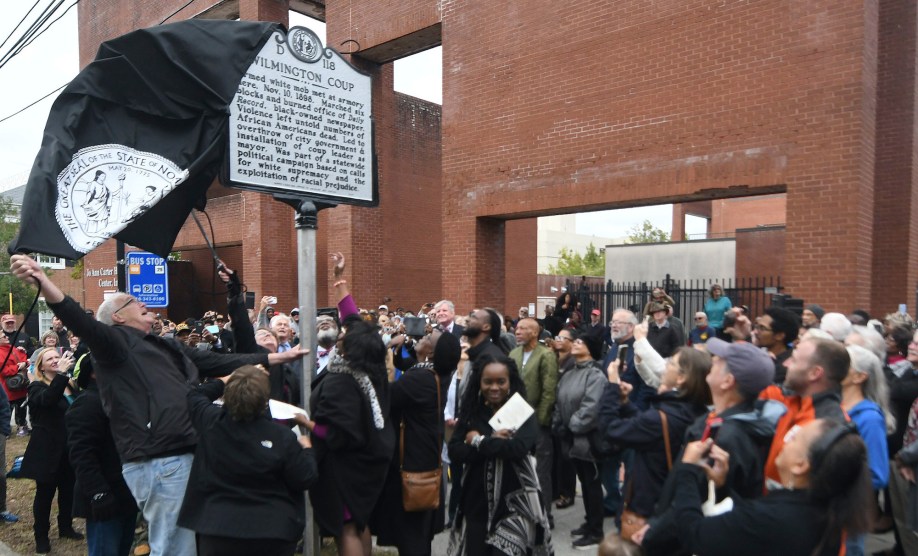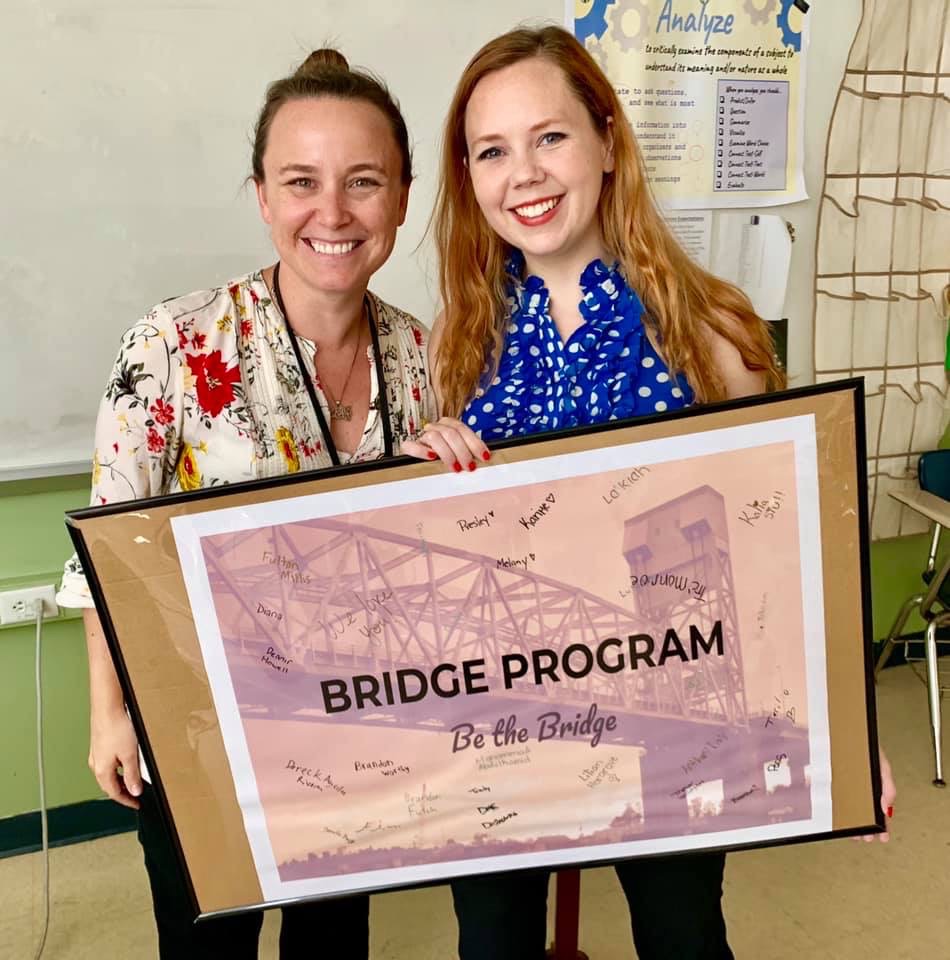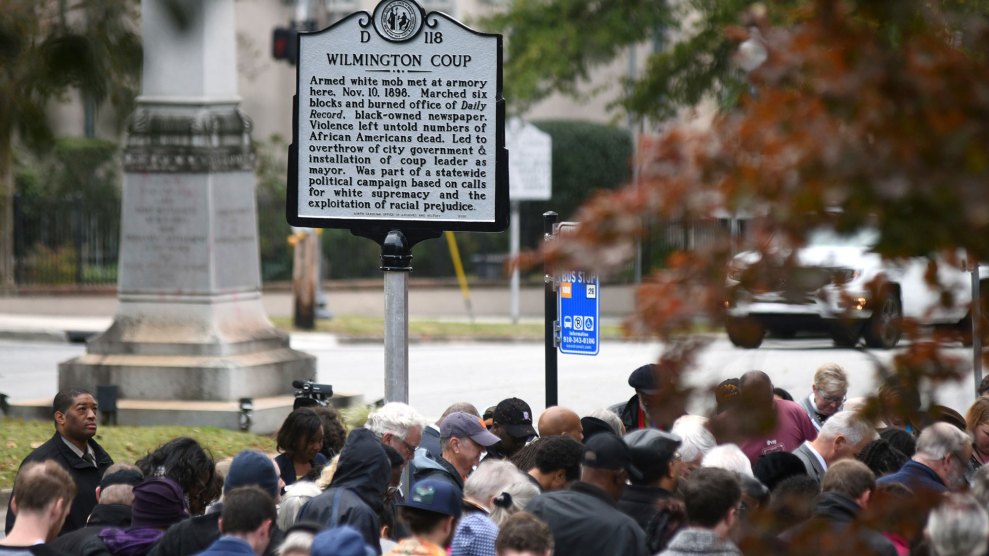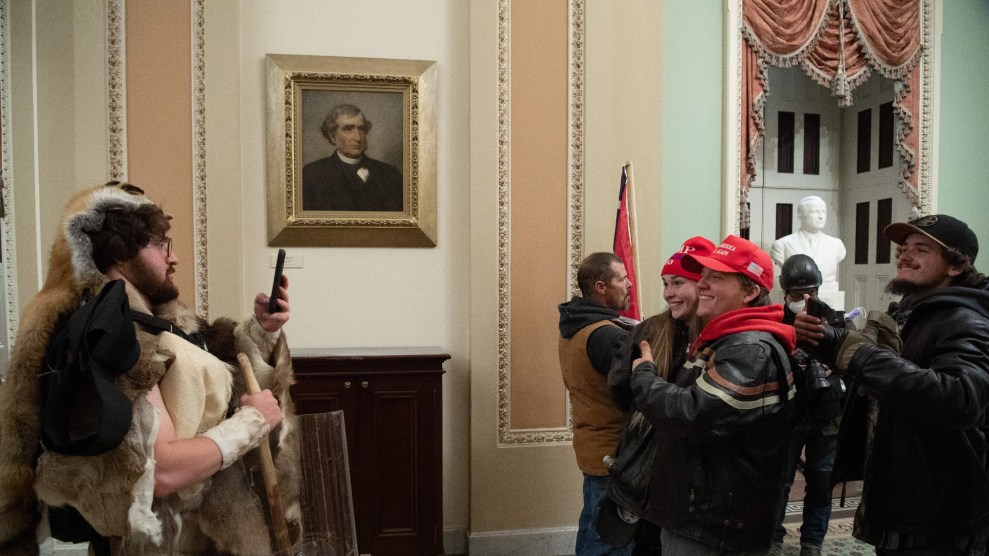
The historical marker to the 1898 Wilmington Coup.Matt Born/AP
For Whitney Coonradt, a social studies teacher at New Hanover High School in Wilmington, North Carolina, the best description of her feelings on January 6 was “unsurprised shock.” For almost two decades, Coonradt has been teaching her students about the “buried” history of the Wilmington insurrection of 1898, when armed white supremacists terrorized and murdered Black residents and overthrew the local government. As my colleague Edwin Rios wrote: “The Wilmington insurrection was, unlike the Capitol siege last week, immediately successful.”
Coonradt grew up in Concord, about 200 miles from Wilmington, and heard rumors of KKK rallies down the road from her house. As she started looking at images of insurrectionists storming the Capitol and documenting it online last month, she remembered a photo of the Wilmington mob posing in front of the burnt building of a Black-owned newspaper. She asked herself: Is this really where we are?
The day after the riot, Coonradt showed her 10th graders in World History and seniors in American History images of the Capitol under siege: members of Congress lying on the floor, a man carrying the Confederate flag, another sitting in the vice president’s chair and holding a cellphone. “You can look at 1898 and talk about why do you think they’re standing in front of this burnt, vandalized building, taking a picture and self-promoting it,” Coonradt says. “And then open for a wider discussion saying well, how does that relate to things now?” She asked her students to share their feelings about the images from January 6. A few were supportive of or even made excuses for the rioters. Others reflected on the disparate treatment of Black Lives Matter protesters over the summer.
Her conversations with students come at a time when North Carolina is debating the implementation of new standards for social studies in public schools for the first time since 2010. One change was logistical: Lawmakers mandated two classes, American History 1 and 2, be consolidated into one to allow for a personal finances course. “They’re spending a year debating how important history is and it’s the course they’re making smaller,” Coonradt says. The decision has made teachers like Coonradt concerned that high school students soon will have access to less comprehensive American history education.
Other revisions that were more meaningful in terms of content have created even more backlash. Proposed changes to the standards aimed at promoting “inclusion of multiple voices”—such as explicit language about slavery, segregation, and voter suppression, as well as references to gender identity and marginalized groups—have been met with resistance by conservative members of the state’s board of education, including Republican Mark Robinson, North Carolina’s first Black lieutenant governor. They charge that the changes are divisive and could foster “anti-American feelings.” The conflict has made teachers like Coonradt concerned that high school students soon will have access to less comprehensive American history education. “It’s a very interesting time for a standards renewal in a very politically divided state,” Coonradt says.
I caught up with Coonradt when she was between classes and in her planning period to talk about the history of her community, the challenges of being a social studies teacher, and the importance of history.
On the racial disconnect in her community about historical events: I’ve been at New Hanover for 18 years—my whole career. It’s basically a 100-year-old school so it has a long history. New Hanover is within a five-minute walk to our local history museum and an antebellum house that has a preserved slave quarter. After reintegration, the school became very diverse, and it’s a big heart of this community.
Our community does a program called One Book, One Community. The second year, we read Blood Done, Sign My Name about the lynching of a man in Oxford, North Carolina, and we hosted the author Dr. Timothy Tyson in our high school campus. He’s white, and he talks about how his father got a job as a minister in Wilmington in the 70’s as it was desegregating. He was part of the more progressive movement, and they would have these community meetings with Black and white people and there seemed to be this big elephant in the room. There was just a really different collective memory of 1898. For the African American community, it was still this large, looming scar, and the white community literally didn’t even know what had happened. It had just been erased. There was this disconnect in the community.
That’s when I was like “Oh my God, I don’t know this thing either. I’m one of these white progressives sitting in the room trying to help school integration and I don’t know this huge thing that the rest of the community is still traumatized by.”
On the difficulties of “teaching things you hadn’t been taught”: I had really amazing history teachers, but it wasn’t something that we did in-depth enough that it stuck or resonated. I actually think that’s part of the problem. There’s a lot of discussion about not teaching [the Wilmington Race Riot]. I don’t think most people aren’t because of conscious resistance to it; it’s just really hard to teach things you haven’t been taught. I don’t want to say I had to teach myself, because we have had a lot of county support and community initiatives to educate on it. But it was not something I got in a formal education in my time. It has been in North Carolina standards for American History 2 for a good while now. We’re way further than we were 20 years ago.
That really pushed me both in terms of 1898, but just in that bigger picture of thinking about history. And it’s definitely the way I frame things when we talk about lynching in my classroom. For most white students, privileged students, there’s no collective memory. It’s not passed down. That’s not the stories your grandparents warn you about. That’s not the talk that they have to have with you.

Whitney Coonradt (left) worked with Elizabeth Felts on a school program called The Bridge.
Courtesy Whitney Coonradt
On what to do when there’s such disparate understanding about history: How do we move forward if we don’t have some of these shared memories? You just can’t be on the same page and heal the same wounds. Not that we don’t all remember and interpret them differently, but even some of the most core things that happened, we don’t collectively agree upon… How do we as a community build? How do we build relationships? How do we move forward if we can’t have this kind of core connection?
It’s a really hard balance because we have a lot of students and people in our community who see this very, very differently. If a student has been told multiple times they can’t wear their jacket with the Confederate flag on it, that’s a pretty good sign that if we open up those discussions, there’s going to be some tension in my classroom.
It is hard history. As much as I’m adamant it must be taught, there has to be flexibility based on what the school and classroom climate is. It doesn’t have to look the same for every teacher. [When] I’ve had groups that are really, really divided, I’m going to do more of a direct instruction, as opposed to open interpretation. And then there are other groups that will be very ready to talk about it and very capable of respectful discourse. It’s really hard to gauge emotionally where my students are and then to monitor the conversations they might be having with each other.
Anytime I’ve been testing the waters, I keep it as close to looking at the history, and then let them kind of marinate on the modern implications. Anchoring it in the past and letting it be implied about the future is sometimes a safer place to have conversations. We talk about what is important for us to remember, trying to frame it as historical thinking skills, and how did this make you feel as an individual.
On the parallels between the Capitol Insurrection and the Wilmington Race Riot: One of things that struck me the most about January 6 was the selfies and the photographs. It’s classic 1898. I became fixated on that idea of the audacity and comfort of documenting and publishing it yourself. The part that gets me the most is not that anyone would even try, but that they would feel so confident in the trying of it and that they were right. That this would work out, and this would be okay. That blew my mind. It started bringing up that picture of 1898 where they’re just standing there posing. They sold postcards of these moments because they so truly believed it was psychologically somehow okay. You can look at that with 1898 and talk about why do you think they’re standing in front of this burnt, vandalized building, taking a picture and self promoting it? And how does that relate to things now?
On the 7th, I stopped everything I had planned and asked students to look at 10 images of the riot, pick one, and tell me what they saw, what they felt, and what it made them wonder. Then they picked a second and third one and did the same thing. A lot of my students immediately went to the racial component. How are they just walking in peacefully after we’ve seen violent attacks of protesters for the last months? Why is it that this time it looks so different? And then there were a few supporters—the moderate line of support, not adamant support. Most of them were kind of apologists.
On the most important reasons to learn about history: What really matters to me is how my students see it and how it makes them feel. They see themselves in one group and they see how that group is treated and it feels very personal. It feels like a value judgment on their humanity. Some people’s humanity and rights matter more than other people’s and they felt that very strongly.
I don’t think many of the students who might feel the opposite of that are going to change their mind just by me forcing it. I think that puts up a wall. It’s part of the reason I just had them reflect on a picture. We’re trying to make them think critically. How do I make sure that it’s not something that comes across as indoctrination? I don’t want to give the other side tools to shut down teaching hard history. At the same time, some of those interpretations are so wrong.
Having a community and facilitating discussions is going to be much more effective at making them think about it differently.
On new standards in teaching social studies: North Carolina is having a big time debate on our state school board over what our new standards are going to be in social studies. Big ideas of what is the purpose of our education, what is the purpose of history, should we be teaching a history that is promoting America and citizenship and pride in country and unity? Or should we be teaching history that is not pro or con America either way. Just deep and diametrically opposed philosophical ideas about what education as a whole, but specifically civic and history education, should be.
What are the things that we are not willing to give up on in a more honest retelling of American history? It’s a constant evaluation of how do I stand by the principles of what is the true history and the hard history and the important history, but also acknowledging that there’s some really strong feelings the other way. Blowing that up isn’t necessarily the most productive way to get there. History will do it.












